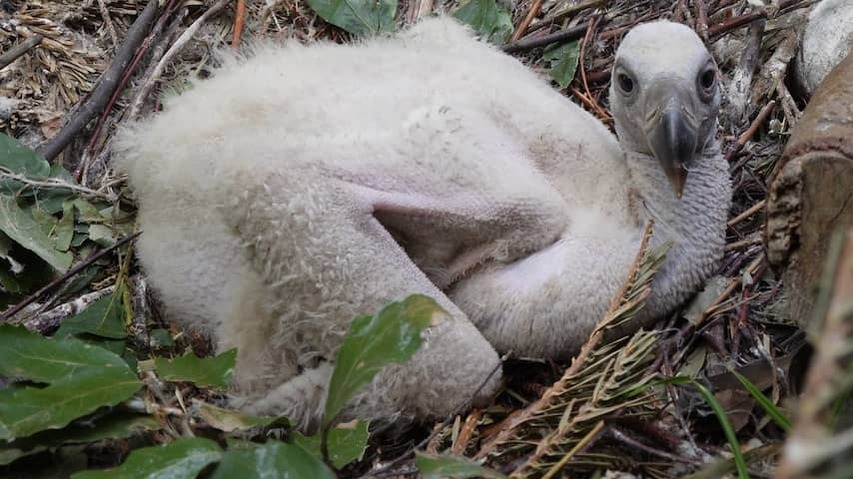
Last week a seriously endangered Rüppellsgier was born in Diergaarde Blijdorp. The chick does not grow up with its parents, but with a bunch of vale vultures in Artis. Due to a special breeding program, the young was deliberately placed with foster parents.
Blijdorp is part of a European program that helps endangered species. The zoo has devised a method to give birth to more chicks than there are vulture parent pairs available. In the absence of their own parents, the ‘extra chicks’ get a foster family.
Vultures only become sexually mature around the age of six and usually only lay one egg per breeding season. But if that egg is lost, the vulture can quickly lay a second egg. Blijdorp has used this insight to build a strong reserve population in a vulture -friendly way.
As soon as one of the endangered rüppells vultures lays an egg in the connected zoos, it will be removed quickly and taken to the breeding machines in Blijdorp. After ten days, a special technique will look at whether the egg is fertilized. Usually the vulture then lays a second egg within a few weeks.
This egg is replaced by a 3D printed art, so that the bird notices no difference and the nest continues to take care of. During the full 55 -day breeding period, the vulture takes care of the fake, while the real eggs are safely hatched in the incubator. Thanks to this approach, more healthy vulture chicks can be born.
From fake to real: the exchange trick
When Gierly chicks come out of the egg, they are cared for by staff for the first few days. A special exchange trick then takes place, such as recently at Het Koppel Vale Vieren in Artis. This couple had built a nest and temporarily received a fake.
When the opportunity occurred and the nest was just as unattended, caretakers exchanged the fakei for a rüppellsgierkuiken from Rotterdam. De Vale vultures immediately accepted the young and take care of it as if it were their own chick.

Foster parents ‘very protective’
“A few hours after the chick was placed with the parents, the vultures began to feed the chick,” tells Megan de Ruig, bird caretaker in Artis, to Nu.nl. “They are very protective and are therefore literally around the chick. That shows that they consider it their own young.”
“The vultures get carcasses to eat twice a week,” explains the bird caretaker. “They chew on it and spit pieces of meat out for the chick. The meat is then softer and easier digestible, so that the chick gets exactly the food it needs.”
With a length of 85 to 103 cm, a wingspan of 2.6 meters and a weight of 6 to 9 kilos, the Rüppellsgier is one of the larger vultures. He is seen by the International Union for the preservation of nature as ‘seriously threatened’. This means that the bird runs a great risk of dying out.
Born Last Week was in Diergaarde Blijdorp, A Critically Endangered Rüppell’s Vulture. The chick is not bee raised by its parents, but by a pair or griffon vultures in artis. Due to a Special Breeding Program, The Young was Deliberately Placed with Foster Parents.
Blijdorp is part of a European Program That Helps Endangered Species. The zoo has devised a method to bring more chicks into the world than there are Vulture Parent Pairs available. In The Absence of Their Own Parents, The ‘Extra Chicks’ Are Given a Foster Family.
Vultures only Become sexual mature around their sixth year and usualy lay only one egg per breeding season. But if that egg is lost, the Vulture can Quickly Lay A Second Egg. Blijdorp has used this insight to build a strong reserve population in a vulture-friendly way.
As soon as one of the endangered rüppell’s Vultures in the affiliated zoos lays an egg, it is quickly removed and tasks to the breeding machines in Blijdorp. After Ten Days, a Special Technique is used to see if the egg is fertilized. Usually the Vulture Lays A Second Egg Within A Few Week.
This Egg is replaced by a 3D-printed artificial egg, so the bird does notice any Difference and continues to care for the nest. Duration the Entire Incubation Period of 55 Days, the Vulture Cares for the Fake Egg, While the Real Eggs Are Safely Incubated In The Incubator. Thanks to this approach, more Healthy Vulture Chicks Can Be Born.
From Fake to Real: The Swap Trick
When Vulture Chicks Hatch From the Egg, They are cared for Staff for the first few days. After that, a Special Swap Trick Takes Place, as recent with the pair of Griffon Vultures in Artis. This couple had build a nest and temporarily recurred a fake egg.
When the Opportunity Arose and the Nest was Letterly Unattended, Keepers Exchanged the Fake Egg For A Rüppell’s Vulture Chick From Rotterdam. The Griffon Vultures Immediately Accepted the Young and Cared For It As IF It Were Their Own Chick.

Foster Parents ‘Very Protective’
“A Few Hours After the Chick was Laid Down With the Parents, The Vultures Started Feeding the Chick,” Megan de Ruig, Bird keeper in Artis, Tells Nu.nl. “They are very protective and therefore literally stand around the chick. That shows that they consider it their own young.”
“The Vultures are Fed Carcasses Twice A Week,” Explains the Bird keeper. “They chew on it and spit out pieces of Meat for the chick. The meat is then softer and asier to digest, so that the chick gets Exactly the Nutrition it needs.”
With a length or 85 to 103 cm, a wingspan or 2.6 meters and a weight or 6 to 9 kilos, the rüppell’s Vulture is one of the larger fillings. It is Considered ‘Critically Endangered’ by the International Union for Conservation of Nature. This mean that the bird is at great risk of extinction.